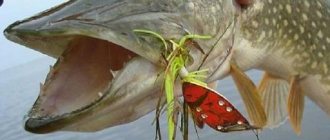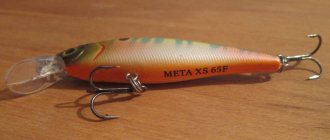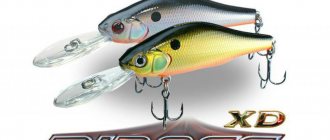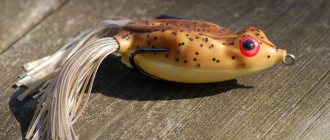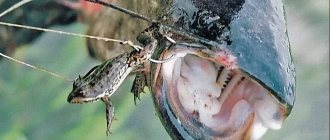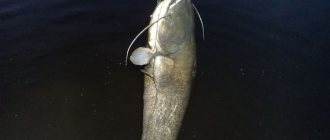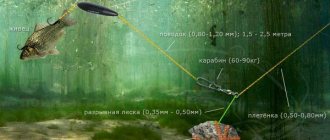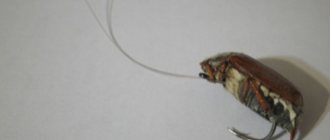When we talk about summer fishing, we imagine the bank of a river and a sleepy fisherman hunched over his fishing rod.
And only true fans of fishing with a spinning rod know how exciting this activity is. It’s especially exciting to organize a real hunt for river predators: pike, catfish or perch.
And knowing what these predators love, you can turn their catching into a real performance or a kind of game. A bait such as a frog will help with this, which can be real, caught nearby, or artificial, perhaps even homemade.
What is an artificial frog?
This bait, popular among fishermen, can be purchased at any specialty store.
Their range is so diverse that it is difficult for a beginner to choose the right one. Therefore, get to know the different types of artificial frogs.
Artificial frogs can be made:
- made of rubber;
- made of plastic;
- made of silicone;
- made of plastic;
At the same time, plastic frogs are much more expensive than rubber ones. Experienced fishermen use homemade frog baits made from various materials, including pieces of fur or wool.
Don’t forget that artificial baits should be stored separately from each other, including frog baits. After all, these are just artificial products that can deteriorate due to random chemical reactions.
Description
Plastic frogs are made of a different material from the material for twisters and worms, it is more durable.
The size of the rubber frog surface bait corresponds to the size of a natural frog - 8 cm. This is the best bait for pike fishing. It is good because it rests on the water with its back up, this is facilitated by the correct loading.
There is a hook on the abdomen, which is protected by a loop-shaped reflector - a spring from such a nuisance as getting caught in the grass. It can be used even where thick thickets of grass stick out from the water.
It is so light - only 10 grams - that you can throw it as far as you need. This bait has only one hook, which is its disadvantage.
To prevent the pike from leaving when fishing, it would be better to have a larger number of hooks. But in this case, the possibility of fishing in the thickets is lost. That is, your bait will constantly cling to the grass.
Frogs of this species are different in purpose and differ from each other in appearance.
If such a bait does not have legs or they look like silicone threads, then it is intended for fishing in areas where there is a lot of algae, mud and just grass above the surface of the water. That is, no protruding parts of the bait will cling and make it difficult to catch fish.
If you are using bait in open water, then the appearance should match the appearance of a real tree frog, as well as its size. The more the bait resembles a natural frog, the greater the chance of attracting the attention of a pike or other predator.
Many varieties of artificial frogs are equipped with “skirts” consisting of lengths of silicone. When lowered into the water, hard and short pieces knock off aquatic vegetation. The semi-rigid protection – a steel cable in a plastic sheath – prevents you from getting tangled in this vegetation.
The front part of the bait frog's abdomen is bright orange. A bright spot on the water helps the angler to navigate correctly and the fish to quickly notice the bait.
Silicone frog: a bait that catches, no secrets
About a year ago I discovered a new pike bait - a frog. That’s how I saw it before in fishing stores, and even fished a couple of times, but unsuccessfully. After which, the frog faded into the background for an indefinite period of time.
And I paid close attention to the bait after my friends and I were fishing last year on an overgrown river, which forms a great many channels. It is unrealistic to fish there with spoons and spinners; jigs are not particularly used, since the depth is no more than 1–2 meters, and there is a lot of grass.
I fished with a spinnerbait and sometimes tried to fish with a popper. There were bites, but I had to abandon the popper, since it really collected grass, and the spinnerbait performed its functions properly, but I had to make sure that the bait did not go deeper than 40 centimeters, otherwise it would collect grass. Meanwhile, my friends caught just a frog, which was equipped with a double hook.
By the way, now in fishing stores you can buy both frogs already equipped (assembled) with hooks, and silicone blanks, which are equipped according to the same principle as regular silicone. There are frogs that already have a weight installed in their body or have their own weight sufficient for casting.
Read: Foam rubber fish: how to make, how many hooks to use, application
A frog is a surface bait, and a floating one; by the way, it comes with legs or a silicone skirt. But, I didn’t try to be too clever, but bought the most ordinary silicone frogs, about 8-9 centimeters long, bought offset printers, put the whole thing together and moved on.
There is some difficulty with casting, but if, in general, the weight of the bait is not enough, you can lightly load the tackle (with pellets, pieces of lead, etc.), with a leash. At the same time, I try to select the load so that the frog barely sinks, but it is better when the bait is always on the surface, this is what allows you to catch fish in thickets of grass, and the hook will always be directed upward or pressed against the body of the bait, which eliminates hooks .
On the other hand, when fishing in toad fields, it is not always necessary to use long casting; this applies to both fishing from the shore and fishing from a boat. This allows you, after casting, not to immediately reel in, but to start performing small twitches. At the same time, during pauses the bait itself will not quickly sink to the bottom (but will spread circles on the surface of the water), but there is not a very large movement of the line, and the frog begins to play on the surface, just what is necessary when fishing in an overgrown reservoir, among the grass .
Read: How to improve the fishing ability of rubber lures?
Please note that the frog can also be placed on an offset hook, making it unhooked, or you can also move the hook outwards. In the second case, there is a higher risk that the bait will begin to collect grass, but the percentage of empty unnecessary bites will also be lower, and when fishing with a frog this is quite a common occurrence. It is not immediately clear when you need to cut.
As my not yet very extensive experience of fishing with this silicone frog has shown, it is still the bait of choice when fishing in overgrown reservoirs, in small areas with grass. Needless to say, by August many rivers become almost toad fields, where it is very difficult to use any other bait. If the frog is mounted on the offset machine as a non-hook type, then the frog will even walk through the grass, among the reeds, there will be no problems at all.
The fishing technique is simple: after casting, you need to perform light twitches and slowly select the line. That's all. The attack of the pike is accompanied by a very violent splash, all this is visible, which adds emotion and pleasure. In general, you won’t be bored with a frog. There are also nuances. As I already noted, attacks on the frog are often observed, although the pike can re-attack the bait. Well, if you buy low-quality silicone, then after 5-10 bites (and sometimes even one bite is enough), the bait can turn into a rag and tear.
Read: Fishing with sinking wobblers
On the other hand, this is a feature of absolutely all silicone baits. It’s still worth paying attention, I’m not writing here what concerns the use of a leash - this is the choice of every angler. But, when the day is “cool”, then a leash is extremely important and necessary, since even “pencils” can easily completely cut off the bait, and some frogs, if you buy good tackle, can cost quite a lot of money.
Since then, I have Croatian eggs (sort of homemade) and silicone frogs, which allow me to enjoy the process of fishing even in areas where there is almost no clear water to be seen, but there are definitely fish there. Good luck and all the best.
In the article I only talked about the direction, as well as the possibility of fishing with such bait. All questions related to the size of the bait, its color and nature of the game, etc. are already a special case, everything is learned in practice.
Subscribe to
our channel in Yandex Zen
Operating principle
Fishing with frog bait begins immediately after the spring flood passes and the water becomes lighter. Ends in late autumn.
By using bait, anglers not only attract the attention of fish, but also increase their chances of catching them. The fish, attracted by the movement of the artificial frog, grabs it and gets hooked. But to do this, it is necessary not only to correctly attach the bait to the hook, but also to guide it along the surface of the reservoir.
Lead, that is, move the frog in jerks along the surface of the water or thickets. But it is in the thickets that predators like to be, and primarily pike. The pike jumps out from below and catches the artificial bait.
The frog is made more natural by jerking movements and waves when the bait is immersed in the water. That is, the skill of the fisherman is also important in this matter. You need to be able to constantly tug the tip of the spinning rod; the amplitude of the shaking should be 8-25 cm.
Non-hooking frog with imitation legs Kosadaka LF22 C56
The main problem for lovers of fishing with surface baits is the high “catchiness” of their baits, their large losses and, as a consequence, self-limitation of fishing areas. Those. fishermen simply avoid fields of lily pads or pondweed, fishing primarily in open spaces and missing out on the opportunity to catch trophy fish. But it is in such thickets that the largest pikes and perches sit.
A wonderful bait in the form of a non-hooking frog with imitation legs Kosadaka LF22 - it very naturalistically imitates a medium-sized frog and fishing with it turns out to be the most spectacular, i.e. absolutely not inferior to fishing with poppers. The bait is made of soft silicone, hollow inside, equipped with a powerful double with a forend hidden in the body, which also contains a load that simultaneously acts as a kind of long-distance casting system typical of wobblers.
A special element, highlighted even in the name of the bait and designed to imitate the legs of a frog, are the silicone brushes on the right and left near the double’s stings. When the silicone frog moves, these brushes make slight chaotic movements, strongly reminiscent of the movements of real frog legs. Obviously, pike and perch really like this and it has been noticed that there are significantly more bites with such silicone imitation brushes.
For the animation of silicone non-hooking frogs with imitation legs Kosadaka LF22, any spinning rod is fundamentally suitable, with the exception of frankly soft ones. With such spinning rods it is more difficult to give the bait the desired movements over long distances, and it also becomes difficult to pull out the bait, with or without a trophy. Accordingly, a spinning rod is desirable to have at least a medium action, be quite powerful and be equipped with a strong cord. It is imperative to use a metal leash, preferably a hard, string one - this way you can avoid the hooks getting tangled in the cord or the bait being cut off by a toothy pike. You can also advise periodically squeezing the bait like a spray bottle and thus removing water from it (a normal occurrence for this bait if there are technological holes in the body). If the frog “drank” the water and does not come to the surface during the retrieve, then calmly continue the retrieve - frogs swim not only on the surface of the water and predators know this very well.
Any wiring of the Kosadaka LF22 bait is acceptable in full accordance with the idea of the nature of the frog’s movement. The wah moves by making jerking movements (this is where silicone imitations of legs perform best) with frequent stops. Moreover, there is a good technique that often gives the expected result! When guiding a silicone frog through thickets of water lilies, it makes sense to lead it onto a plant leaf and stop for 5-10 seconds. Then pull the bait off the sheet and continue wiring. And rest assured that the toothy one is definitely watching this bait and often instantly reacts to its continuation of movement.
The bite of pike, perch or asp, as noted above, is always spectacular, accompanied by splashes and splashes - the fisherman’s emotions are overflowing! But when there is a splash, you shouldn’t hook right away, but it’s better to wait for a blow to the hand and only then hook. This technique gives the best results and requires remarkable endurance from the fisherman.
Kosadaka LF22 is available in several colors and in a single weight of 6 grams. The bait size is 35 millimeters - most suitable for the conditions of most reservoirs
Design
Unhooked frog
The design of an artificial frog bait is very simple: a light, hollow body with a weight inside. A non-hooking frog can be purchased at the store, or you can make it yourself.
Moreover, amateur fishermen make baits of various appearances; imagination plus skillful hands and the catch will delight you.
Stages of making an artificial frog from wool:
- Cut a piece of wool about 10 cm in size.
- Tie a knot so that two ends stick out.
- Wrap it with threads to create the shape of the frog's body and hind legs.
- Add wool for the front legs , wrap them with threads - you should get a small ball with two short front legs and two long hind legs.
The simplest homemade frog is two vibrotails and a twister welded together. And you can cook them with a simple lighter.
This homemade product is also good because it is sinking. It sinks into the water slowly, after another jerk, and this attracts fish.
How to catch a frog?
When passing bait through thickets, it is important to jerk the spinning rod correctly - short but sharp.
You can do jerks either single or double, but it is better to alternate them. Don't forget about a 3-5 second pause between jerks.
A predator watching a frog waits for this exact pause to attack its prey. Having grabbed an artificial frog, the fish does not immediately realize its mistake and tries to gradually swallow it.
You need to hook the predator slowly so that it has time to swallow the bait.
Where to fish and when?
It is better to use non-hooking baits in shallow water areas, the depth of which is up to a meter or less. There may be thickets of sedge or reeds, as well as algae and duckweed.
In such hard-to-reach places, an artificial frog is the best bait; it simply jumps over all obstacles - be it a water lily or grass. Fishing places should be chosen not where real frogs live, but not far from them.
This is probably why July and August are considered to be the “frog” season. More bites occur when real frogs are hunting for insects, that is, in the evening. According to the observations of anglers, pike react to real frogs before real frogs begin to appear.
With the help of an artificial frog you can catch any predatory fish. On river reservoirs it is mainly: pike perch, ide, pike, perch, catfish. But as experienced fishermen say: “You need a live frog. He’s not a fool, he follows the scent.”
Fishing with a live frog
In summer, the easiest time to catch a live frog is in the evening or in the morning, before the dew has dried. During the day, especially in the heat, frogs hide in thick grass.
When it gets cold, you need to look for frogs in shallow water, where they hide under stones and logs near the shore. For bait, take small or medium-sized green frogs, it is better if the frog is young.
Frogs are caught with nets and collected in a fabric bag. If it is difficult to catch with a net, then you can use a simple fishing rod. You can attach any blade of grass to the hook.
Seeing the bait near its muzzle, the frog rushes and swallows it. Instead of bait, you can use flies, which are stored in linen bags with fresh grass.
There are examples where fishermen themselves breed frogs in the garden.
To do this you need:
- Collect frog eggs.
- Place it in a shallow container with water.
- Place the container in the sun.
- After 2 months, the frogs can be used for bait.
Popular non-hooking frogs for pike
Most often you can find the following bait models on sale:
Predator-Z Frog Booyah Pad Crasher
- Booyah Pad Crasher is a fairly heavy (about 14.5 g) frog with a length of 6.3 cm. Suitable for long casting and hard-to-reach places. Easily sinks to a depth of 1.5-2 m and looks natural in the water.
- Predator-Z Frog - Does not cling to vegetation and still creates splashes like a live frog. Bundles of rubber strips are attached to the back of the bait. It is recommended to use this model for fishing on the surface of a reservoir overgrown with water lilies.
Video: catching pike with a frog
The hook-free frog is compact and easy to use, so anglers can carry it with them during the warm season when tracking pike. Not every body of water is suitable for using this type of bait, but when you find yourself in the right place and the bite starts, you can enjoy the spectacle of fishing to the fullest.
Views: 225
Similar articles:
- Catching pike with unhooked hooks in grass and snags Pike is a predatory fish that lives and hunts in hard-to-reach...
- Pike fishing. What baits and tackles are best? Fishing for pike is one of the most enjoyable activities. Pike...
- Catching pike in the grass. Grass pike for spinning Late spring, summer, early autumn - at this time there are small...
- Catching pike with silicone. The best silicone lures for pike Silicone lures for pike are baits that are consistently popular...
How to plant?
It's a shame, but live frogs are not used; they must be killed before hooking. Usually the frog is mounted by two lips and a hind leg.
Two hooks are sometimes used for the bait. In this case, the back is pierced with one hook, and the soft part of the hind leg with another.
According to experienced fishermen: the more hooks, the better. The same goes for fishing with a frog.
The frog can be strung on three hooks, having previously connected them together for rigidity. In this case, the hooks are inserted into the front legs and head, and the hind legs are bandaged and connected to the fishing line.
Description and characteristics of a live frog as fish bait
Many fishermen legally consider a live frog to be the best bait. Pike and catfish will happily swim to a hook on which a live frog hangs. However, some experienced fishermen prefer to use not only live ones, but even dead ones.
Such a bait is hooked onto a hook either by the muzzle and the hind leg, or 2 hooks are used, with one hooked on the back and the other on the paws. When using a live frog as bait, as well as when using a false representative of this amphibian, the most important thing is how the frog on the hook will be lowered into the water. Everything should be done as believably as possible, as if the green individual itself jumped into the water.
Where and how can you get live frogs?
In most cases, the loud frog lives in swampy areas and this amphibian is more active in our region during warm and hot summers, namely from June to August. Based on this, we can say with complete confidence that you need to catch a frog in such an area.
So, in the warm season, in order to catch a frog you need to arm yourself with a net .
But, if suddenly the fisherman’s catch turns out to be too bouncy and the amphibian does not want to succumb to this tool, then you need to try using a regular fishing rod . In order to catch a frog with a regular fishing rod, you need to attach a blade of grass to the hook.
also a rubber false frog as bait in this case . After the amphibian smells the aroma of such a “lure”, it will definitely not remain indifferent, and as a result, it will no longer be a rubber frog, but a real frog hanging on the hook.
Some fishermen also use as bait - flies . The caught flies are kept in wicker baskets or cotton bags. It is recommended to put some freshly picked grass in the fly bags.
Among fishermen, these are especially common among somyatniks, there are those who breed frogs themselves . As a rule, they practice this craft in their garden plots. To do this, they collect frog eggs on a lake or river in the summer, which they then place in a container of water; a tank is also suitable for these purposes.
The key to this is that the container you use should be shallow.
Then the container is placed in a place well heated by the sun's rays. Now you just need to wait, as a rule, after two months the fisherman will already have baby frogs ready to use as bait.
Key points in breeding frogs at home
We have already outlined above how to breed frogs, so now we will only mention a number of very important points and requirements, on the observance of which the overall success of the business started depends.
So, the mandatory factors when breeding frogs yourself are:
- Breeding requires solar heat. Just a warm, closed space, like an apartment, is not suitable for these purposes.
- You need to very careful about the container , or rather its shape, in which young frogs will be grown. In particular, the selected container should not have great depth.
- Breeding frogs needs to be done in advance , so that the young offspring of frogs are ready at the right time, since their growth process can hardly be called extremely short, since you will have to wait about 2 months. If we also take into account that summer in our region is quite short, this means that if you do not take care in advance about the availability of live bait, grown yourself, you may not have time, then you will have to wait for the opening of the next fishing season.
If we take into account all these nuances, then any ardent fisherman who decides to raise his own frogs for bait will certainly achieve good results and after a short period of time he will be hooking fishing rods with frogs of his own production.
How to hook a frog?
Option for attaching a frog to a hook
All fishermen, even those who are just beginning to learn the art of this interesting craft, know that in this business every little detail is important; unimportant, insignificant moments simply do not exist here. So, it is important not only to catch or raise a green amphibian, you also need to be able to hook it correctly. So, a frog, even hanging on a hook, should look as much like a living and healthy reptile as possible. Moreover, this applies not only to living, but even to dead green amphibians.
So, if a dead frog is prepared as bait , then the double, that is, the hook, needs to be inserted into its mouth, and the sharp ends need to be brought to the surface of the spine. Thanks to such techniques, when guiding, the frog will literally draw circles on the water, thereby looking more and more like a living individual.
If live fish are used for fishing , then in this case the hook attachment will be radically different from the first case, since it will not tolerate carrying the hook through the mouth. In most of these cases, the frogs are caught by the hind leg or a hook wire is passed through the skin of the back, carefully, without touching the spine.
At the same time, in order to avoid causing wounds to the skin of the reptile with the sharp ends of the hook, at the preliminary stage you need to prepare small foam balls, which are recommended to be painted green or brown. These small dots of foam need to be placed on the tips of the hook, in this case they will not harm the skin of the reptile, which will give it the opportunity, even when on the hook, to look as realistically as possible like a living, free frog.
Techniques for catching a live frog: tips and tricks
Using a live frog as bait is, in principle, no different from a rubber bait. Live bait suspended on a hook must retain its ability to perform its traditional movements.
If for any reason this function of the amphibian’s physiology is disrupted, then it will not resemble an ordinary frog full of life. As a result, the predator, that is, the fisherman’s potential prey, will not pay any attention to it.
Today they are very common attributes of fishing, and each fisherman uses the wah that he likes best, but regardless of which of these wahs the blue Neva worker chooses, the result is important. If you follow the recommendations proposed in this article, a successful catch will not take long to arrive!
Adviсe
Fishing with a frog is an entertaining process during which the angler watches the fish hunt and catch the bait.
The fisherman must know and be able to:
- How to choose the right bait, taking into account the fishing location and the type of fish.
- How to correctly create the appearance of a living jumping frog by twitching a spinning rod.
- How to properly hook a caught fish by waiting a few seconds.
If you have been fishing with a frog at least once, you will love this activity!
